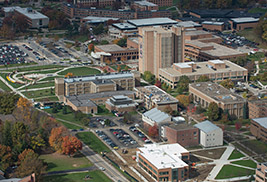Featured Article
Kent State Faculty Researchers to Study Summit Street Improvement
Kent State University’s Office of the University Architect is collaborating with a group of faculty members to add a research and education component to the upcoming construction project on East Summit Street.
read moreKent State and Youngstown State Collaborate to Improve Youngstown’s Downtown-to-Campus Area
Posted Oct. 5, 2015Through a mutual agreement between Kent State University’s College of Architecture and Environmental Design and Youngstown State University’s Center for Urban and Regional Studies, more than 75 Kent State students will spend the next year working on projects aimed at connecting downtown Youngstown, Ohio, with the Youngstown State campus.
The goal is to spark revitalization by demonstrating the potential for reuse and redesign in the area, says Douglas Steidl, dean of Kent State’s College of Architecture and Environmental Design.
“Youngstown’s downtown has seen a renaissance; these students will assist the city in advancing their accomplishments to further serve the citizenry,” Steidl says.
Youngstown State’s Center for Urban and Regional Studies is acting as the local contact for the city, bringing its experience and knowledge of Youngstown to Kent State’s design studios, says Michael A. Hripko, associate vice president for research at Youngstown State.
“This collaboration is a sign of the exceptional progress made in downtown and the university’s dedication to making this city a true destination for living, learning and working,” Hripko says.
The project is a part of Kent State’s Community Fund initiative, which provides resources to faculty willing to engage with a city by selecting design projects oriented toward future development. The goal is for students to further their education by experiencing actual clients, and for the city to obtain conceptual visions that can be used as a baseline for continuing implementation. Ideally, the city will use these outcomes to work more effectively with design firms on future implementation of prioritized concepts prepared by the students, Steidl says.
Under the agreement, Kent State is committing the following to the city of Youngstown over the next academic year:
- College of Architecture and Environmental Design’s senior undergraduate architecture studio: This fall semester, the student studio will spend the entire semester examining potential programing for sites along Wick Avenue, Phelps Street and Hazel Street. The studio will engage with city, nonprofit and private leaders during the design process to re-envision possibilities for investment and reuse.
- College of Architecture and Environmental Design’s Cleveland Urban Design Collaborative’s annual Midwest Urban Design Charrette: This three-day event is a partnership between three academic institutions – Kent State’s College of Architecture and Environmental Design, Lawrence Tech’s College of Architecture and Design and Ball State’s Urban Design Center. Their work will focus on urban design strategies to connect the United Wean river site to the Youngstown State campus along Hazel and Phelps streets.
- College of Architecture and Environmental Design’s Master of Landscape Architecture and undergraduate Architectural Studies studios: In spring 2016, students will spend their semester in Youngstown imagining potential landscape design projects that would enhance the livability and economic viability of sites within the city.
For more information about Kent State’s College of Architecture and Environmental Design, visit www.kent.edu/caed.
For more information about Youngstown State’s Center for Urban and Regional Studies, visit http://web.ysu.edu/contentm/easy_pages/view.php?sid=25&page_id=913.
